#optolong filter
Explore tagged Tumblr posts
Photo

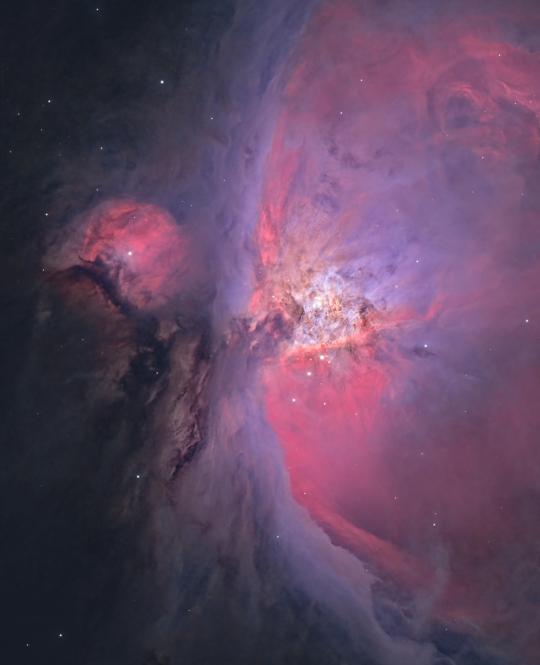
orion trapezium core by u/brownieboy2222 via r/astrophotography
photographer’s notes:
Stacked and processed in pixinsight with RC Astro plug ins. Used HDR composition to not blow out the core
Scope:Askar 103APO, Camera: ASI533MC pro, mount: HEQ5, Askar 52mm guide scope + asi 120 guide camera. Optolong Lenhance dual narrowband filter
This was a lengthy processing workflow for me. First time trying HDR comp and I think it came out pretty well
#orion trapezium core#astrophotography#space#nebula#orion#stars#elements#photography#brownieboy2222#u/brownieboy2222#r/astrophotography#reddit#photographers on reddit#astronomy#adsl note ->#original is the second vertical shot#i rotated left for the primary slot cuz i like how it will look in the archive#aesthetic#m42#orion nebula
936 notes
·
View notes
Text
IC 1805, aka The Heart Nebula. Using a William Optics Redcat 51-II-U telescope, using an Optolong L-Quad filter. Stacked 72 300s images. Astrobin link in comments.
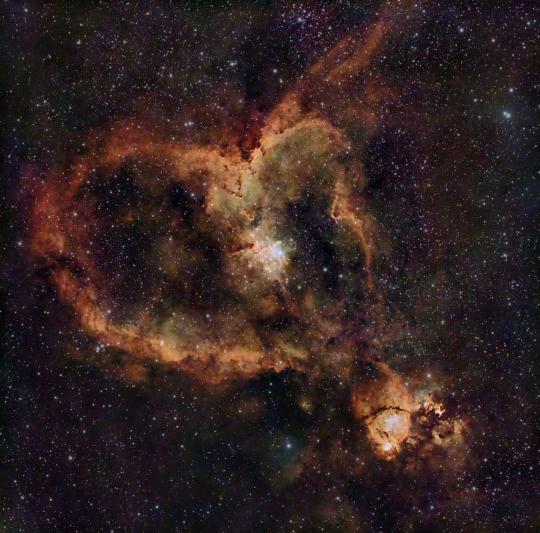
This image does not include any data from my previous attempt at imaging the Heart Nebula. This is new data using a different filter.
#astronomy#nasa#astronomers#universe#astrophotography#nasa photos#nasawebb#astrophysics#outer space#hubble space telescope#nebulosa#nebula#cosmos#galaxies#galaxy#goddard space flight center#james webb images#hubble#astrology#astro community#astro notes#astro observations#astroblr#astrology observations#astronauts#space exploration#space#space photography#space science#our universe
110 notes
·
View notes
Text

Imran Badr
"Located in the Constellation Aquarius, Helix Nebula is one of the closest bright objects to the Earth. Also known as Eye of the God, it is at a distance of 655 light years from us.
I captured 5hr50m of 300s subs of this object over 3 nights from my house in San Jose, CA (Bortle 7) in late Aug 2023 using Celestron 9.25EdgeHD telescope (2350mm focal length), ASI2600mcpro one shot color camera and Optolong L-Ultimate dual narrow band filter.
I stacked and processed in PixInsight with some final touches in Photoshop.
You can see higher resolution of the image at: https://astrob.in/cz1epv/0/ "
28 notes
·
View notes
Text

cool view
[Petr Horálek]
BEAUTIFUL COMET PONS-BROOKS
Stack
FB: www.fb.com/PetrHoralekHotography
IG: www.instagram.com/petrhoralek
Web: www.petrhoralek.com
Tech Info: Canon Ra, Tamron 70-200mm (200 mm), ISO 5000, f2.8, 47x15s, tracked on Vixen Polarie-U. Used Optolong L-Pro filter (pretty helpful for ion tail).
Story: After three weeks of cloudy days, I could finally try to catch the brightening comet 12P/Pons-Brooks, which is every day more and more beautiful. My attempt to catch comet 12P/Pons-Brooks on the evening of 3 March 2024, around 7PM UT, brought me to Zdiar, Slovakia, where I found a piece of clear skies after 140 km of driving. Unfortunately, strong light pollution from Zakopane city in the direction of the comet made the photography more challenging. Also, there was no free view in the direction of the comet, so I kept a tree from the exposures in the field of view. Eventually, it looks pretty nice, I think 🙂
3.4.24 • Facebook
writing from the instrumental womb (of the heart & spirit) to “connect” feels like the silence of the night sky…
by pointing to our beautiful mysterious Creator
And i personally do so as well through the writing of instrumental music and poetry to relate to others who care to “see”
1 note
·
View note
Text
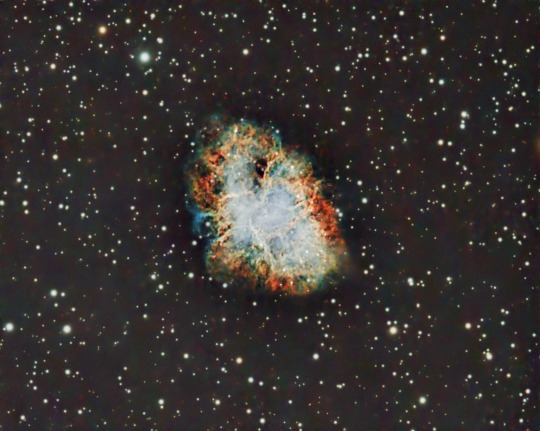
M1 - Crab Nebula
See full resolution image at: https://www.astrobin.com/rejqjs/
The Crab Nebula (catalogue designations M1, NGC 1952, Taurus A) is a supernova remnant and pulsar wind nebula in the constellation of Taurus. The common name comes from a drawing that somewhat resembled a crab with arms produced by William Parsons, 3rd Earl of Rosse, in 1842 or 1843 using a 36-inch (91 cm) telescope. The nebula was discovered by English astronomer John Bevis in 1731. It corresponds with a bright supernova recorded by Chinese astronomers in 1054 as a guest star. The nebula was the first astronomical object identified that corresponds with a historically-observed supernova explosion.
The nebula was independently rediscovered in 1758 by Charles Messier as he was observing a bright comet. Messier catalogued it as the first entry in his catalogue of comet-like objects; in 1757, Alexis Clairaut reexamined the calculations of Edmund Halley and predicted the return of Halley's Comet in late 1758. The exact time of the comet's return required the consideration of perturbations to its orbit caused by planets in the Solar System such as Jupiter, which Clairaut and his two colleagues Jérôme Lalande and Nicole-Reine Lepaute carried out more precisely than Halley, finding that the comet should appear in the constellation of Taurus. It was in searching in vain for the comet that Charles Messier found the Crab Nebula, which he at first thought to be Halley's comet. After some observation, noticing that the object that he was observing was not moving across the sky, Messier concluded that the object was not a comet. Messier then realized the usefulness of compiling a catalogue of celestial objects of a cloudy nature, but fixed in the sky, to avoid incorrectly cataloguing them as comets. This realization led him to compile the "Messier catalogue"
At an apparent magnitude of 8.4, comparable to that of Saturn's moon Titan, it is not visible to the naked eye but can be made out using binoculars under favorable conditions. The nebula lies in the Perseus Arm of the Milky Way galaxy, at a distance of about 2.0 kiloparsecs (6,500 ly) from Earth. It has a diameter of 3.4 parsecs (11 ly), corresponding to an apparent diameter of some 7 arcminutes, and is expanding at a rate of about 1,500 kilometres per second (930 mi/s), or 0.5% of the speed of light.
At the center of the nebula lies the Crab Pulsar, a neutron star 28–30 kilometres (17–19 mi) across with a spin rate of 30.2 times per second, which emits pulses of radiation from gamma rays to radio waves. At X-ray and gamma ray energies above 30 keV, the Crab Nebula is generally the brightest persistent gamma-ray source in the sky, with measured flux extending to above 10 TeV. The nebula's radiation allows detailed study of celestial bodies that occult it. In the 1950s and 1960s, the Sun's corona was mapped from observations of the Crab Nebula's radio waves passing through it, and in 2003, the thickness of the atmosphere of Saturn's moon Titan was measured as it blocked out X-rays from the nebula.
This RGB image is a total of a little under 6 hours of integration over 2 nights (2/18/24 and 2/25/24) consisting of:
- 190 x 60s light frames
- 61 x 120s light frames
- 10 x 180s light frames
Processed in PixInsight using the new GradientCorrection tool (which really helped with the moon-induced gradients on the data taken 2/18).
Celestron C9.25 Edge at F/10
ZWO ASI2600MC Pro Camera
Optolong L-Pro filter
ZWO AM5 mount
Astromania 50mm f/4 Guide Scope
ZWO ASI120MM Mini Guide Camera
ZWO ASIAIR plus controller
1 note
·
View note
Photo

Jupiter - 9-19-2020 . Jupiter with the OptoLong L-Enhanced filter shot in monochrome . Nikon Z6, TeleVue Powermate 5, 10" Dobsonian (1200mm) . . . #astronomy #astrophotography #photography #jupiter #highpointscientific #lenhanced #optolong #televue #oriontelescopes #nature #naturelover #ganymede #io #europa #photography #filter #rhodeisland #providenceri #halpha #oiii (at Providence, Rhode Island) https://www.instagram.com/p/CFX8q6vp_67/?igshid=zazzxo0xpyoc
#astronomy#astrophotography#photography#jupiter#highpointscientific#lenhanced#optolong#televue#oriontelescopes#nature#naturelover#ganymede#io#europa#filter#rhodeisland#providenceri#halpha#oiii
0 notes
Text
M42/M43, NGC 1976, Orion Nebula
M42/M43, NGC 1976, Orion Nebula
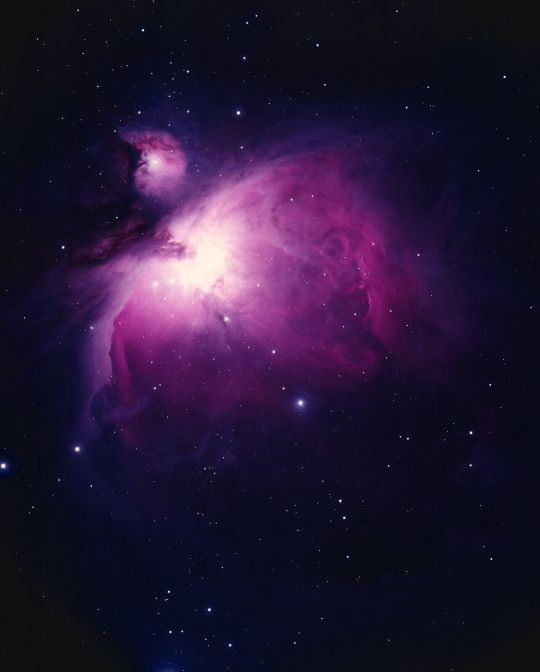

APOD: 2019 December 17 - The Horsehead Nebula

The Orion Nebula
First try with HDR in pixinsight, hope you like it ! -Equipment- Scope: TS-Optics 94/414 EPDH (414mm focal) Camera: ZWO ASI533MC Pro at -25°C gain 101 offset 49 Guiding: ZWO OAG Guiding camera: ZWO ASI 120MM Mount: Skywatcher AZ-EQ6 Filter: Optolong L-eXtreme -Acquisition- Light : 62x300s + 88x120s Total integration time 8h Dark: 100x300s Flat-50 Bias-100 100s120s Date : 30 January 2022 07,26,27 Febuary 2022 Location : France-Alsace Bortle 4/5 -Software- Carte du Ciel, N.I.N.A, Phd2 , PoleMaster and PixInsight Ez Processing Suite from darkarcon darkarcon website : darkarchon.internet-box.ch:8443/ -Pre Processing in PixInsight- Image Calibration Cosmetic Correction Debayer Subframe Selector Star Alignement Local Normalization Image Integration Drizzle x2 Dynamic crop -Processing *HRD* DBE 300s and 120s StarAlignement -> register 300s and 120s HRDComposition -> blend 300s and 120s frame Split L,R,G,B Chanel __L__ Ez_Deconvolution Ez_Soft Streatch HDRMultiscaleTransform StarNet++ for build nebula mask UnsharpedMask with mask LocalHistogramEqualization with mask __RGB__ ChanelCombination(RGB) BackgroundNeutralization PhotometricColorCalibration Ez_Soft Streatch HDRMultiscaleTransform Starnet++ SCNR star mask __LRGB__ LRGBCombination Ez_Denoise StarNet++ Final CurvesTransformation Save as jpg Clear skies !

Orion nebula M42 , SHO Hubble palette from Singapore.
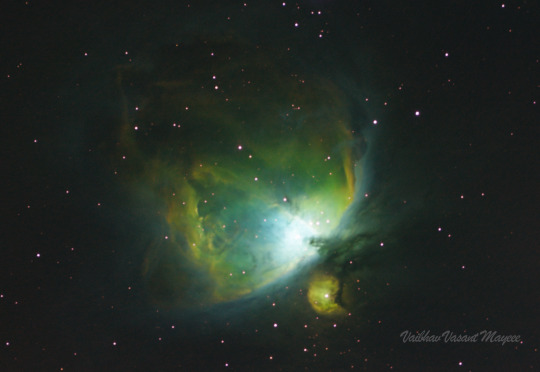
Horsehead Nebula in Orion
The Horsehead Nebula and Flame Nebula. This iconic deep-sky object is a dark nebula in the constellation Orion. Astrophotography tips, facts, and more.

Orion Nebula wallpaper by DLJunkie - Download on ZEDGE™ | 5dcb

Orion
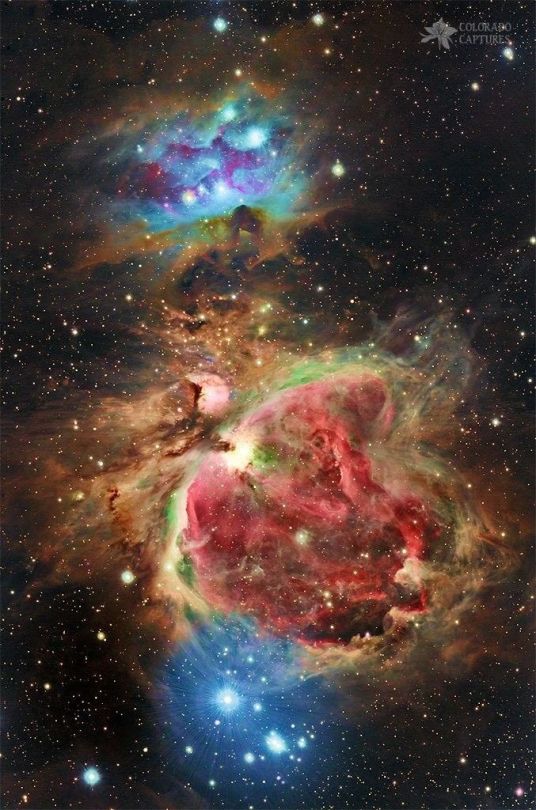
The Orion Nebula (M42/M43, NGC1976/1982) This picture shows the great nebula in the constellation of Orion the Hunter. On a good clear night, from a dark site well away from the lights of modern civilization, this glowing cloud of gas and dust can be seen with the naked eye as a fuzzy patch surrounding the star Theta Orionis in the Hunter's Sword, below Orion's belt. It is probably the most spectacular of all the objects cataloged by Charles Messier and now called by their `M' numbers. M42 had been known since the beginnings of recorded astronomy as a star, but it is so outstanding that it was first noted as an extended nebula in 1610, only a year after Galileo's first use of the telescope. Detailed descriptions started appearing later in the seventeenth century, and it has been a popular target for anyone with a telescope ever since. So many details are visible in even a small telescope that M42 will more than repay the observer who makes it a frequent target, and who will find that it is hard to make a realistic sketch that can capture all of the finer features. So outstanding is this nebula that it has two numbers. M43/NGC1982 is the separated portion to the north-east (top left), surrounding an irregular variable star. Although Messier stopped at only two, other parts of the nebula in this region have received further NGC numbers. M42 is our closest example of an HII region, being composed mainly of ionized hydrogen which gives off the red glow so dominant in every picture of the nebula. Deep photographs such as this one show that it is nearly a degree across, larger than the full Moon (although the Moon is so bright that it looks much larger). The energy to keep the nebula glowing comes from the very hot young stars in a formation called the Trapezium, embedded in the brightest part of the nebula and not visible in this photograph. The nebula and the brighter stars are very young indeed by astronomical standards, at about 30000 years. Compare this to our own Sun, which is considered to be a middle-aged star at over four billion years! M42 probably contains several hundred stars younger than a million years, still bursting with the energy of youth. Stars are still being born in a dense cloud behind the nebula, but they are hidden from our view by a concentration of dust which reduces their light to only a million-millionth of its original intensity. Fortunately, astronomers have developed special cameras and other detectors which are sensitive to infra-red radiation, more popularly known as heat, which penetrates the dust and reveals to us this stellar nursery. Although M42 is mostly hydrogen, in both neutral and ionized states, with a fair quantity of dust, it does contain significant amounts of other elements, especially oxygen. The green glow of doubly-ionized oxygen is strongest near the intense ultraviolet starlight at the middle of the nebula. To the north-east (the upper left in this picture) is a feature called the Dark Bay, which is a thick cloud of neutral gas which has not yet been ionized. Location: 05 hrs 35.4 min, -05 deg. 27 min (2000). Distance: nearly 500 parsecs (1600 light-years). Size: about 66 by 60 arc minutes. Mass: about 300 solar masses. Magnitude: 4.0. Power source: O and B stars. Photograph: Bill Schoening, KPNO 4m telescope, October 1st 1973. Original Ektachrome color transparency.Credit:Bill Schoening/NOIRLab/NSF/AURAUsage of NOIRLab Images and VideosAre you a journalist? Subscribe to the NOIRLab Media Newsletter.Image FormatsFullsize Original20.7 MB Large JPEG1.2 MBScreensize JPEG144.3 KBZoomableZoomableWallpapers1024x768131.3 KB1280x1024203.7 KB1600x1200314.3 KB1920x1200411.5 KB2048x1536568.3 KBCrossfade image:Optical (DSS2)Infrared (2MASS)Crossfade image:
2 notes
·
View notes
Photo
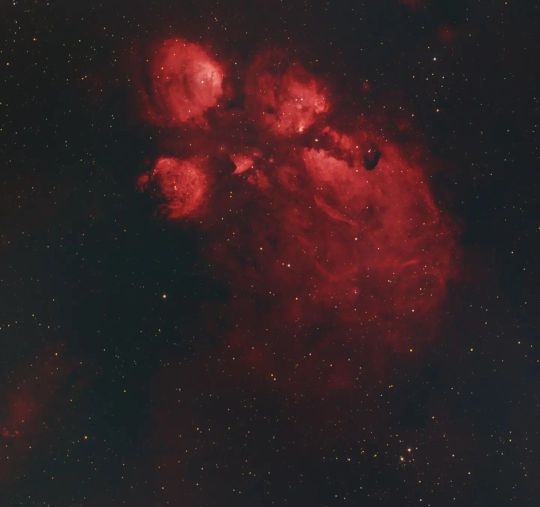
Cats Paw or Bears Paw Nebula. Just a quick one. I managed a couple of hours, there's fainter nebulosity in the background a few more hours would easily bring that out. The cats paw nebula is an emission nebula and star forming region. Gear Skywatcher F5 750mm Newtonian ASI533 OSC Saxon NEQ6 pro Optolong L-enhance filter Nexsus .75 reducer/corrector QHY5L-IIM camera and scope for guiding. Exposure, 180s. Gain 100. Offset 70. Cooled-5c. #Astrochick #universe #photography #skywatcher #skywatcheraustralia #practicalastrophotography #womeninastrophotography #practicalastrophotographymagize #spaceart #astrogirl #nightskyporn #astrophotography #amateurastrophotography #universetoday #astrophotographyporn #farpointastro #nightskyphotography #longexposurephotography #photographyeveryday #deepskyastrophotography #space #backyardastronomy #outerspace #apod #photographylovers #optolongfilters #zwoasi #astronomydaily #nightsky https://www.instagram.com/p/Chvd6xgv-Yj/?igshid=NGJjMDIxMWI=
#astrochick#universe#photography#skywatcher#skywatcheraustralia#practicalastrophotography#womeninastrophotography#practicalastrophotographymagize#spaceart#astrogirl#nightskyporn#astrophotography#amateurastrophotography#universetoday#astrophotographyporn#farpointastro#nightskyphotography#longexposurephotography#photographyeveryday#deepskyastrophotography#space#backyardastronomy#outerspace#apod#photographylovers#optolongfilters#zwoasi#astronomydaily#nightsky
3 notes
·
View notes
Photo







When it comes to astrophotography, you can have as many fancy telescopes and cooled astro cameras and expensive high-capacity mounts you want, but half the work lies in processing the data you gather with that equipment and the skill you do it with. I’m still fairly new to the hobby, but it doesn’t take long to learn that there may be far more detail hidden in the data you gather than you might originally think.
I first took this image of the Andromeda Galaxy in November 2020. It was taken via long exposures on a black and white, cooled astro camera and through RGB filters. Once the exposures were stacked and the RGB data combined, it still had to be heavily processed, with only the core of the galaxy faintly visible. You would think there’s nothing else to be seen, but once you begin playing with the levels, scratching the data, fantastic things are revealed.
The first time I tried this, I didn’t get far. Neither did the second try. But I didn’t stop there. As I learned more about processing, I tried a few more times, with the latest attempt done 5 months after the data was gathered. This time, pretty much the entire galaxy became visible, and the colors were much better and more accurate than previous attempts.
There may still be even better ways to process this data, but ultimately I will need to gather much more once peak Andromeda Season arrives again, this time with my new Optolong L-Pro filter, and see what can be done then.
40 notes
·
View notes
Photo

M42, as known as the Great Orion Nebula.
I took this photo over two nights (4h+ total exposure) and processed it as HOORGB composite - 1mn sub-exposures for HOO and 30s for RGB. Took from a class 5 bortle site.
Gear used : Sony a7iii (3200iso) camera - William Optics Zenithstar 61ii (360mm) refractor - SkyWatcher Star Adventurer equatorial mount - Optolong L-eXtreme light pollution narrowband filter.
Softwares used : Siril, Photoshop.
#astrophotography#william optics#zenithstar#astronomy#m42#orion#nebula#nebulae#stars#space#deepspace#apod
63 notes
·
View notes
Text

“M17 Omega Nebula”
The Omega Nebula, also known as the Swan Nebula, Checkmark Nebula, Lobster Nebula, and the Horseshoe Nebula is an H II region in the constellation Sagittarius. It was discovered by Philippe Loys de Chéseaux in 1745. Charles Messier catalogued it in 1764.
Magnitude: 6
Radius: 11 light years
Age: 1.001 million years
Distance: 5,000-6,000 ly
Constellation: Sagittarius
I took this image using my Explore Scientific ED102 triplet APO CF telescope, ZWO asi294mc pro, on an iOptron IEQ45 pro mount using an Optolong L-Extreme filter, controlled by the ASIair pro.
2 notes
·
View notes
Text

The Moon and Saturn 🌙 🪐 🥰
Photo by: @danborjaa
🔭 Nexstar 6SE
📷 ASI290MC / 533MC
TeleVue Barlow 2x
Optolong UV/IR Cut filter
ZWO ADC
Composite 📷
34 notes
·
View notes
Photo

First stack and post-processing on last night's Andromeda Galaxy (M31) capture. William Optics Gran Turismo 81 IV (480mm focal length, F/5.9) w/6AIII x0.8 flattener (total effective focal length with flattener is 384mm, F/4.7), Sky-Watcher EQ6-R Pro mount, Nikon D5100. Optolong L-Pro light pollution filter. 111 x 120 second lights (3 hours 42 minutes total integration), 30 darks, 30 bias. ISO 800. Stacked in Astro Pixel Processor, post processed in Abobe Photoshop Express and Paintshop Pro X7. Will probably play with the post-processing again to see if I can get more of the dust lanes showing without too much sky glow haziness. #astroimaging #astrophotography #astronomy #williamopticsgt81 #williamoptics #skywatcher #skyandtelescope #nightskyphotography #nikon #andromedagalaxy (at Westminster, Maryland) https://www.instagram.com/p/CHyY1FynCVM/?igshid=137xe16asn13y
#astroimaging#astrophotography#astronomy#williamopticsgt81#williamoptics#skywatcher#skyandtelescope#nightskyphotography#nikon#andromedagalaxy
1 note
·
View note
Photo

M31 - The Andomeda Galaxy I have been attempting processes of this target since I began dabbling in astrophotography, 10 months on this data imparticular. Many people have given me tips and ideas, and they have all helped, but learning how to remove stars to process the target and the stars separately has finally given me a final product I am happy with. Images were stacked in DeepSkyStacker, initial color balance and stretch in Siril. Used Siril to help balance background. Processed in Photoshop. . Link to full resolution at astrobin.com in bio . 191 x 60s - 800 ISO (9/2/21) 91 x 120s - 400 ISO (9/3/21) Dark, flat, dark flat, and bias frames Providence, RI - Bortle 8 . Radian Raptor 61 Canon EOS Ra Optolong L-Pro filter Sky Watcher EQ6-R Pro ZWO 30mm f4 MiniScope (guide) ZWO asi224mc (guide) Pegasus Powerbox Advanced . . . #astrophotography #astrophoto #astronomy #photography #highpointscientific #hpscollections #OPTeam #myOPTgear #agenaastro #astromaniacmag #m31 #andromedagalaxy #andromeda #milkyway #space #cosmos #stars #galaxy #ig_spaceimage #ig_astrophotography #optolonglpro #optolongfilter #canoneosra #canonphotography #CanonFavPic #apod #NASA #rhodeisland #astrobackyard #radiantraptor61 (at Providence, Rhode Island) https://www.instagram.com/p/CgUF3g3OQ8v/?igshid=NGJjMDIxMWI=
#astrophotography#astrophoto#astronomy#photography#highpointscientific#hpscollections#opteam#myoptgear#agenaastro#astromaniacmag#m31#andromedagalaxy#andromeda#milkyway#space#cosmos#stars#galaxy#ig_spaceimage#ig_astrophotography#optolonglpro#optolongfilter#canoneosra#canonphotography#canonfavpic#apod#nasa#rhodeisland#astrobackyard#radiantraptor61
14 notes
·
View notes
Text
What’s need to be cared when you select fluorescence filters !
1. What is fluorescence filter ?
Fluorescence filter is a key component used in biomedical and life science instruments.
It’s main function is to separate and select the characteristic band spectrum of the substances’ excitation light and emitted fluorescence in the biomedical fluorescence inspection analysis system .
Generally speaking , a fluorescence filter set consists of three different filters.
①Excitation Filter (Size φ25×5mm)
②Emission Filter (Size φ25×3.5mm)
③Dichroic Mirror (Size 25.7×36×1mm)
The excitation filter is responsible for selecting appropriate excitation light wavelength ,such as screening white excitation light into blue light ,which is used to excite fluorescein such as GFP .
(Note: If a single-wavelength LED light source is used ,the excitation filter can be omitted . )
The emission filter is responsible for screening the required fluorescence emission light .When the excitation light excite different emitted light ,the emission filter can distinguish different emitted light . In addition ,because many biological tissues have auto-fluorescence and the auto-fluorescence is mostly in red region ,the emission filter can be used to filter out the interference of auto-fluorescence .
(Note: If there is only one kind fluorescence in the sample and no auto-fluorescence interference,the emission filter can be omitted .)
The dichroic mirror is to distinguish excitation light and emission light ,so it’s a very important role .
2. Characterictics of fluorescence filter :
Deep blocking , low auto-fluorescence , good flatness ,which are helpful to get clear fluorescence imaging . Therefore, a good fluorescence filter uses single-piece transparent glass (e.g., B270 ,fused silica) as the substrate and is coated on both sides of the glass . Compared with the conventional fluorescence filter which use multi-piece glued glass or absorbtive glass assisted cut-off, the single-piece type has obvious advantages in fluorescence imaging and the production difficulty is higher ,so the cost will also be higher .
Optolong fluorescence filters are coated on single-piece transparent glass .
(https://www.optolongfilter.com/en/products/fluorescence-filters)
3. Application of fluorescence filter :
Fluorescence filters are widely used in the instruments of life science and biomedicine , including fluorescence microscopy ,laser scanning confocal fluorescence microscopy (LSCM),confocal microscopy, total internal reflection fluorescence microscopy (TIRFM), flow cytometry , RT-PCR and so on .
4. Select suitable fluorescence filter :
How can we select a suitable fluorescence filter for our experiments ?
The principle of selecting fluorescence filter is to allow the fluorescence/emission light pass through as much as possible at the imaging end , while completely blocking the excitation light, to obtain the highest signal-to-noise ratio .
Especially for the application of multi-photon excitation and total internal reflection microscopy,
the weak noise will laso cause great interference to the imaging effect,so the SNR is required to
be higher .
Usually we look at the transmittance spectrum of filters ,but for the selection of fluorescence filters , we need to refer to the cut-off spectrum .
When selecting excitation filter and emission filter , the intersection OD value of the two filters is an important criterion . Generally , it is required that intersection OD of wild-field light source excitation is greater than OD5 , and laser excitation is greater than OD6 , so as to achieve a better fluorescence signal-to-noise ratio .
Sometimes the combination of excitation transmitted spectrum and emission transmitted spectrum looks perfect,but after coverting to OD value , it is found that the spectral intersection is only OD1,which does not meet the basic requirements of fluorescence imaging . Therefore, it is generally recommended that the transmission spectrum of excitation light and emission light have a certain distance, such as 10nm .
Fluorescein can also be used to select filters . First , we need to determine the excitation and emission spectra of fluorescein we are using . The filter spectra and fluorescein spectra are then overlapped to determine the suitability of the filter .
Of course ,when selecting a filter, you also need to consider the spectrum of excitation light source , especially mercury lamps,metal halide lamps and white LEDs ,to avoid selecting areas with weak light sources .
5. Obtain fluorescence filters
Optolong Optics Co., Ltd is a professional manufacturer of optical filters , which established in year 1999 . For nearly 20 years,we have provided professional service to hundreds of companies in domestic and overseas , from the begining of incoming material processing, OEM customization , to now focus on three areas : Fluorescence filter ,OEM Bandpass filter and Astronomical filters .
Link to web www.optolong.com to know about us . You are sure to get a suitable and cost-effective optical filters in Optolong .
1 note
·
View note
Photo
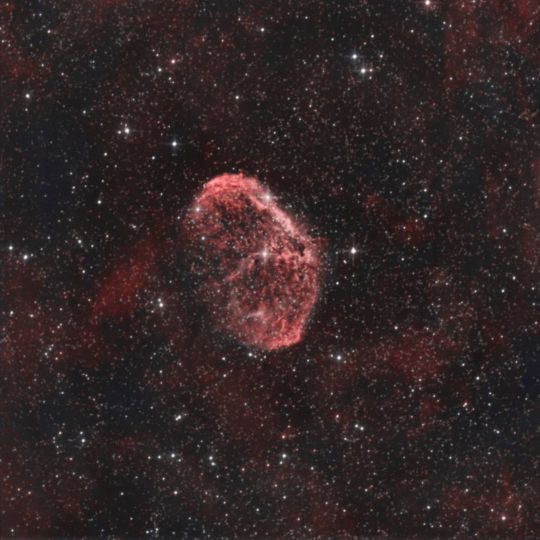
The Cresent Nebula 🗓 6.08.2021 🌓 7% moon 🕰 3hr x 300sec subs, 100gain. 🔭 Skywatcher F5 750mm Newt. 📷 ASI533 🕶 Optolong L-enhance 💻 APT, Phd2, Pixinsight, Stellarium, Sharpcap & Photoshop. Darks & Flats I haven't stretched this one to its full potential. I want to get more hours with my CLS-CCD filter instead of my lenhance to try and get a bit of that outer green colour. So this is a W.I.P :) #deepskyphotography #universetoday #outerspace #stars #deepskyobject #spaceart #astrophotography #deepsky #spacegirl #nightskyphotography #nightskyporn #apod #aapod2 #skywatcheraustralia #astroworld #cosmos #longexposure #asi533 #nebula #telescopes #backyardastronomy #astrobin #astronomy #astrochick #astromaniacmag #cresentnebula (at Astrogirl.au - Backyard Observatory) https://www.instagram.com/p/CSOZKV5pYeW/?utm_medium=tumblr
#deepskyphotography#universetoday#outerspace#stars#deepskyobject#spaceart#astrophotography#deepsky#spacegirl#nightskyphotography#nightskyporn#apod#aapod2#skywatcheraustralia#astroworld#cosmos#longexposure#asi533#nebula#telescopes#backyardastronomy#astrobin#astronomy#astrochick#astromaniacmag#cresentnebula
2 notes
·
View notes